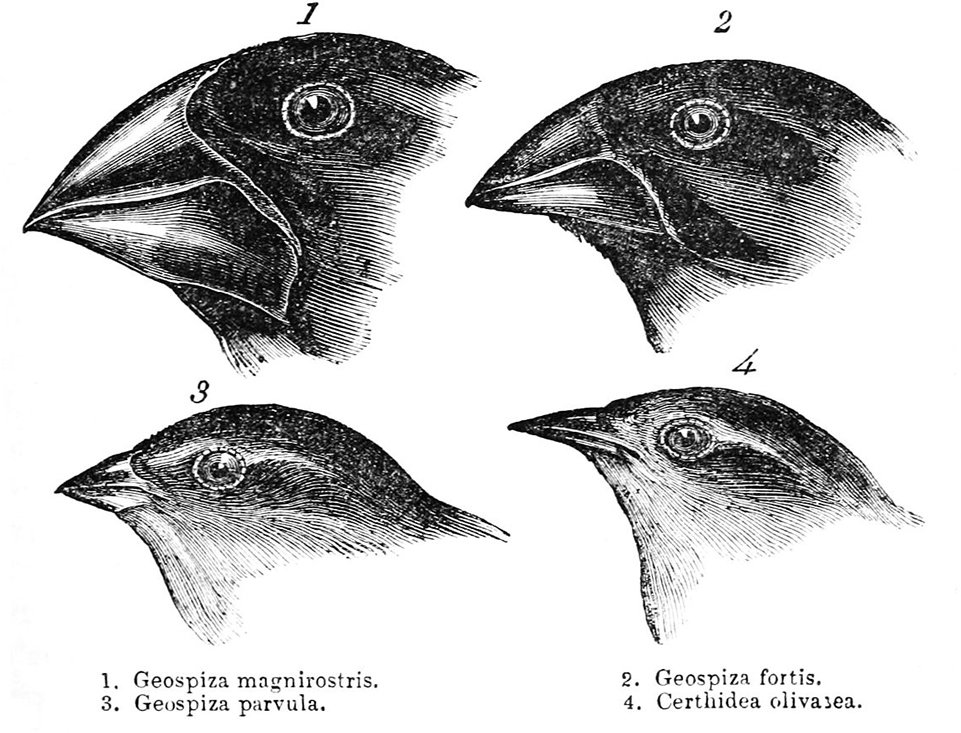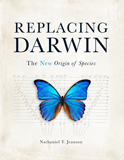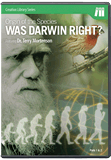A Bombshell for Replacing Darwin?
At-a-Glance
- Darwin’s voyage on the HMS Beagle led to the formal scientific discovery of the finches that are native to the Galápagos Islands.
- These finches have been the icon of real-time evolutionary change for decades.
- New research documents the process of finch speciation in real time.
- The rate of speciation strongly contradicts the expectations of evolution and strongly confirms the predictions that I made in Replacing Darwin.
Four months ago, I published a book, Replacing Darwin: The New Origin of Species, in which I argued for a revolutionary thesis. I claimed that the progress of science over the last 150 years has not only rebutted Darwin’s central arguments for evolution; it has also replaced them with an entirely different scientific explanation for the origin of species. Recent research1 in the Galápagos Islands on Darwin’s finches—the modern poster child for evolution—has confirmed this bold pronouncement.
So What?
To understand the larger significance of this confirming evidence, consider the history of the creation-evolution debate. For years, evolutionists have insisted that, as a scientific explanation for the origin of species, young-earth creation (YEC) is inferior to evolution. In fact, evolutionists have claimed that YEC fails to meet the basic criteria for inclusion in “science.” In other words, evolutionists have long claimed that YEC is pseudoscience.
Why? For an explanation to be considered scientific, it has to make testable predictions. In other words, it has to be falsifiable. For example, gravity is a well-established scientific theory. It makes testable predictions. You can test them right now by picking up a book (like Replacing Darwin) with your hand and then releasing it. If you’re standing on earth, gravity predicts that the book will fall. If it doesn’t, you have good reason to question gravity. And if it repeatedly fails to fall, you would have grounds for claiming that the theory of gravity has been falsified. Evolutionists have proclaimed for years that YEC is not falsifiable—that there was nothing the scientific community could do to test whether YEC was a legitimate scientific explanation.
The Tables Begin to Turn
In contrast, in Replacing Darwin, I published several testable, falsifiable predictions that arose from a YEC explanation for the origin of species. For example, in the book I explored the rate at which new species formed. I highlighted several lines of evidence indicating that the average rate of speciation for creatures like mammals (think elephants, giraffes, and zebras), amphibians (such as frogs and salamanders), reptiles (like turtles, snakes, and lizards), and birds is much higher than evolutionists claim. Instead of requiring millions of years to form, I showed multiple independent lines of evidence indicating that tens of thousands of species arose in just a few thousand years. This conclusion leads to testable predictions. Since, by evolutionary standards, this timeframe represents the blink of an eye, the YEC explanation predicts that species should still be forming right now. Four months ago, I put this prediction in print.
The YEC explanation predicts that species should still be forming right now.
In fact, in chapter 6 of Replacing Darwin, I walked the reader through very detailed calculations on what the rates of speciation might be. Since mammals are familiar to most people, I focused on the numbers for these types of creatures. Applying these calculations to birds, we can predict the rate at which new species should form. For example, in birds, about 11,000 recognized species exist.2 If birds formed new species at a constant rate over 4,500 years, then on average about 2.4 new species should form every year (11,000 species / 4,500 years = 2.4 species per year).
To clarify, in Replacing Darwin, I highlighted at least two ways this average rate could have been realized. The first way is via a steady, plodding rate of speciation—one that is constant with time. In other words, under this first way, speciation rates may have been 2.4 new species per year, every year. The second way is via a burst of speciation in the years immediately following the Flood, followed by a tapering off as you get closer to the present. In other words, several thousand years ago, the rate might have been, say, 24 new species per year, whereas now it might be 0.24 new species per year. As long as the long-term average is 2.4 new species per year, either of these ways is consistent with the YEC timescale. Both of these ways lead to predictions that we can test.
Furthermore, these predictions stand in stark contrast to evolutionary expectations. Using the evolutionary interpretation of the fossil record as a guide, living birds have formed one new species every 6,000 years.3 In other words, evolutionary timescales posit 0.0002 new species per year—a rate that is 1,000 times slower than the slowest YEC rate that I listed in the preceding paragraph.
A Tantalizing Hint
Since the 1700s, species have been discovered at a rapid rate. At times, the number of new species has grown at a very steep pace; at other times, the pace has been less steep. For example, over the past 80 years, new bird species have been discovered at a fairly constant, linear rate: about six new species per year. Since 2013, about 2.4 new species have been discovered per year.4
Does this mean my prediction (i.e., for a steady, plodding rate of speciation) has been confirmed? The problem with these numbers is that no one knows whether these new species formed recently. It could be that these species had been in existence for thousands of years and then were discovered recently. To differentiate between these two explanations, we would need (as I wrote in Replacing Darwin) “the full accounting of the morphological, genetic, and reproductive separation in two candidate species populations at two different time points. A speciation event would manifest itself as an overlap (i.e., non-isolation) between the populations at one time point followed by isolation at another.”5 In October 2017, I knew of no such accounting between two different time points for any mammal, amphibian, reptile, or bird species. (By “two different time points,” I mean time points that were witnessed in real time, not inferred from evolutionary models about the fossil record or about genetics.) Thus, my predictions remained untested.
A Surprising Find
At the beginning of this year, I began in-depth exploration of a potential test of these predictions. Since our offices are located in Northern Kentucky, I gathered data on native species of our area, on potential observation sites of these native species, and on required manpower for a long-term experiment that would test the rate at which species form in real time.
However, on January 12 of this year, a landmark study on a famous evolutionary icon was published.6 To appreciate the significance of this particular set of species for the wider origins debate, consider the history of Darwin’s finches. Darwin himself was directly responsible for their formal introduction into the modern scientific vocabulary. During his voyage on the HMS Beagle in the 1830s, Darwin stopped at the Galápagos and collected several finch samples.7 In 1837, John Gould declared these samples to be new species.8 Regarding the origin of these species, Darwin himself famously remarked, “The most curious fact is the perfect gradation in the size of the beaks in the different species. . . . Seeing this gradation and diversity of structure in one small, intimately related group of birds, one might really fancy that from an original paucity of birds in this archipelago, one species had been taken and modified for different ends.”9

Darwin’s finches. Image by Shyamal, via Wikimedia Commons.
Darwin’s hypotheses would have to wait over 100 years before they could be directly tested. Since the 1970s, Princeton’s Peter and Rosemary Grant have been bringing these finches to the forefront of evolutionary research. Their observations of the action of natural selection in real time have made their studies textbook science.10 It’s hard to imagine a set of species that represents a better evolutionary Exhibit A.
In addition to their research on natural selection, in 2018 the Grant’s team published a remarkable new finding. For several decades, they had been documenting the morphological, genetic, and reproductive separation in Darwin’s finches. Over this time period, they observed “rapid hybrid speciation in Darwin’s finches”11 [“hybrid” simply refers to the way in which this species formed; in this case, individuals from separate species bred to found a new, third species]. Specifically, “The newly founded population of Darwin’s finches is an incipient hybrid species, reproductively isolated and ecologically segregated from coexisting finch species.”12 Even more remarkable, “Homoploid hybrid speciation [a specific mechanism by which new species form] is believed to be a generally slow process extending over hundreds of generations, but, as the present example shows, it can be established in only three generations”13 (my emphasis added in bold). My experimental plans for Northern Kentucky were superseded by something even better: the poster child for evolution had already confirmed what I set out to test.
To be sure, this Galápagos finch study is still very preliminary. In fact, the authors were hesitant to even label these unique birds a new species. Given its recent origin, small population size, and consequent danger of extinction, the authors were cautious in their conclusions. Understandably, the scientific community will be cautious in their labeling until long-term observations are performed. Nonetheless, despite these caveats, the scientists still witnessed the bona fide formation of an “incipient hybrid species.”
Furthermore, this type of speciation event—a hybrid speciation event, in which a new species is formed from the interbreeding of two separate species—was even more significant in light of a publication three years prior. In 2015, a group of scientists sequenced the genomes (the complete DNA sequence) of the 18 finch species14 on the Galápagos Islands and the nearby Cocos Island. They concluded, “We find extensive evidence for interspecific gene flow”15—interspecific gene flow refers to the passing of DNA among species. In addition, “Hybridization has given rise to species of mixed ancestry”16 (emphasis mine). In other words, the type of speciation event that the Grants’ team observed is exactly the type of speciation event that is thought to have played a role in the formation of the original 18 finch species.
Predictions Confirmed
What do these results imply for the predictions of Replacing Darwin? In terms of timescale, the Grants witnessed the beginning of the formation of the “incipient hybrid species” in 1981. Yet they began their observations in the 1970s. In other words, scientists have been trying to document the formation of new species from these finches for about 50 years. For sake of argument, let’s conservatively assume that no new additional species formed from the other finch species on the Galápagos Islands or the nearby Cocos Island. Taking these existing species into account (i.e., the “original” 18 finch species present before the formation of the incipient hybrid species), we can conclude that 1 new species formed per 50 years per 18 species.
If this rate held true across all bird species, we can extend our conclusions even further. Let’s multiply this rate by the total number of living bird species (i.e., about 11,000): 1 new species formed per 50 years per 18 species * 11,000 species = 1 / 50 / 18 * 11,000 = 12 new species per year. This is even faster than I predicted. In other words, one of the only published studies to date that gives a “full accounting of the morphological, genetic, and reproductive separation in two candidate species populations at two different time points” yields results exactly in line with the predictions of my book.
Let’s be even more generous. As I mentioned earlier, the first of these 18 Galápagos finch species were documented in 1837.17 For sake of argument, let’s say that “the full accounting of the morphological, genetic, and reproductive separation” among these species began in 1837. (It could not have begun in 1837 since genetics wasn’t yet a field of science, but we’ll use this date anyway.) Under this assumption, scientists have observed only 1 new species form per 181 years per 18 finch species. Applied to all bird species: one new species formed per 181 years per 18 species * 11,000 species = 3.4 new species per year. The match between this number and my prediction is almost perfect.
Let’s return to the raw data. The formation of 1 new finch species from these 18 in just ~50 years is far in excess of the predicted evolutionary rate. For example, in the 2015 paper on the DNA of these species, the authors published their timeline for the historical origins of these species.18 The authors claimed that, over the past 900,000 years of evolutionary history on the Galápagos and Cocos, 40,000–80,000 years were required for 1 new species to form. This evolutionary rate is several hundred times slower than what the Grant’s team observed.19 No wonder the authors of the 2018 study labeled their observations rapid speciation.
Anyone who wishes to challenge my conclusions has a ready means of refuting what I’ve just said.
Anyone who wishes to challenge my conclusions has a ready means of refuting what I’ve just said: Show me a study that gives the “full accounting of the morphological, genetic, and reproductive separation in two candidate species populations at two different time points” and that contradicts this rate. (And, no, showing a study based on evolutionary assumptions about millions of years is not relevant to a debate when the evolutionary timescale is the point in question. Circular reasoning is an irrational way to resolve a scientific debate. To compare YEC and evolutionary timescales head-to-head, we need a study done in real time.)
More Surprises to Come?
Will this incipient species go extinct as rapidly as it formed? Perhaps. But another new species might arise in its place. In fact, this cycle of speciation and extinction might happen repeatedly over the next several decades. If so, this might add to the evidence in support of my published predictions. For example, the current rate of speciation—12 new species per year—is 5 times higher than my predicted rate of 2.4 new species per year. If 5 speciation-extinction cycles occur in Darwin’s finches before a permanent species is formed, the adjusted rate of speciation (i.e., the long-term rate of speciation) will fall exactly in line with what I predicted. (What I predicted is, technically, a long-term rate anyway.) And it will magnify the discrepancy between predicted long-term evolutionary rates and reality.
But let’s think of the worst-case scenario for the YEC timescale. Let’s say the new hybrid species goes extinct as quickly as it formed. And let’s say this extinction event is not followed immediately by a new speciation event. What will this imply for Replacing Darwin? On one hand, it might imply that species have not formed at a plodding rate but, rather, in a short burst immediately following the Flood. Alternatively, since over 10,982 bird species still roam this planet, it might also imply very little. The “full accounting of the morphological, genetic, and reproductive separation” among all of these >10,982 species “at two different time points” has a long way to go. In other words, the extinction of this hybrid species would simply revert us back to the state in which I found myself in October of last year when I wrote the book—a state of waiting for these results to come in.
Until then, we’re left with some very promising initial results. Wouldn’t it be ironic if the breakthrough for YEC science came from the most famous icon of real-time evolution?
Editor’s Note: A typo in an early version of this manuscript was corrected.
Footnotes
- Sangeet Lamichhaney et al., “Rapid Hybrid Speciation in Darwin's Finches,” Science, 359, no. 6372 (2018): 224–228.
- HBW and BirdLife Taxonomic Checklist v2 was downloaded from http://datazone.birdlife.org/species/taxonomy on February 12, 2018. The number of recognized bird species was extracted from this Checklist. “Recognized” species were identified and separated from “not recognized” species via the identifiers in column G of the Checklist table.
- “We found that the most recent common ancestor of modern birds inhabited South America around 95 million years ago, but it was not until the Cretaceous-Paleogene transition (66 million years ago) that Neornithes began to diversify rapidly around the world.” Santiago Claramunt and Joel Cracraft, “A New Time Tree Reveals Earth History’s Imprint on the Evolution of Modern Birds,” Science Advances 1, no. 11 (2015): 1, doi:10.1126/sciadv.1501005. Dividing 66 million years by 11,000 bird species yields an average rate of 6,000 years for a new species to form.
- A timeline for the discovery of new bird species was extracted from the “Authority” column of the HBW and BirdLife Taxonomic Checklist v2.
- Nathaniel T. Jeanson, Replacing Darwin (Green Forest, AR: Master Books, 2017), 160.
- Sangeet Lamichhaney et al., “Rapid Hybrid Speciation in Darwin's Finches.”
- James T. Costa, Darwin’s Backyard: How Small Experiments Led to a Big Theory (New York: W. W. Norton and Company, 2017).
- J. Gould, “Remarks on a Group of Ground Finches from Mr. Darwin’s Collection, with Characters of the New Species,” Proceedings of the Zoological Society of London 5 (1837): 4–7. See also David Lack, Darwin’s Finches (Gloucester, MA: Peter Smith, 1968).
- Charles R. Darwin, Journal of Researches into the Natural History and Geology of the Countries Visited during the voyage of H.M.S. Beagle Round the World (London: John Murray, 1845), 379–380.
- For example, see their textbook that summarizes their work: Peter R. Grant and B. Rosemary Grant, 40 Years of Evolution: Darwin’s Finches on Daphne Major Island, (Princeton University Press: Princeton, 2014).
- Sangeet Lamichhaney et al., “Rapid Hybrid Speciation in Darwin's Finches.”
- Ibid., 228.
- Ibid., 228.
- Sangeet Lamichhaney, et al., “Evolution of Darwin’s Finches and Their Beaks Revealed by Genome Sequencing,” Nature 518, no.7539 (2015): 371–375, doi:10.1038/nature14181.
- See the abstract of Sangeet Lamichhaney, et al., “Evolution of Darwin's Finches and Their Beaks Revealed by Genome Sequencing.”
- Ibid.
- As per the HBW and BirdLife Taxonomic Checklist v2, for the species I listed in an earlier footnote.
- See Figure 2a, Extended Data Figure 4c, and page 2 of the Supplementary Information section for Sangeet Lamichhaney, et al., “Evolution of Darwin’s Finches and Their Beaks Revealed by Genome Sequencing.”
- I.e., 40,000 years / 181 years = 221-fold difference; 80,000 years / 181 years = 442-fold difference.
Recommended Resources

Answers in Genesis is an apologetics ministry, dedicated to helping Christians defend their faith and proclaim the good news of Jesus Christ.
- Customer Service 800.778.3390
- © 2024 Answers in Genesis








